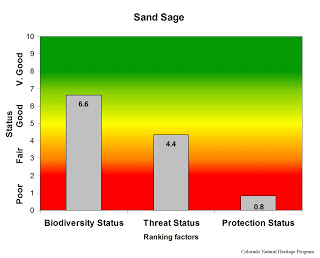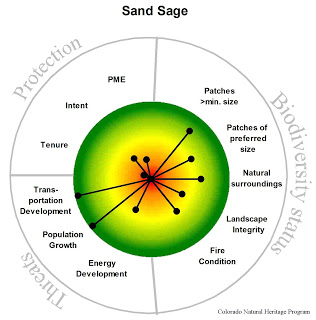
These shrublands dominate sandy areas on Colorado’s eastern plains, where they often intermingle with shortgrass prairie to form a locally patchy sandsage-shortgrass matrix. Occurrences are characterized by sand sagebrush with an understory of tall, mid- or short grasses and scattered forbs. Yucca and snakeweed are common in some areas. A variety of small mammals and burrowing reptiles live here where soils are easy to excavate. Typical species include kangaroo rats, plains pocket mice, grasshopper mice, western rattlesnakes, and western hognose snakes. Rarer species that are typical of this habitat include greater and lesser prairie-chickens, Cassin’s sparrows, and ornate box turtles. Fire and grazing are the most important dynamic processes for sandsage ecosystems, although drought stress can impact this system significantly in some areas.
Sand sage shrublands cover nearly two million acres in Colorado, and more than 80% of this is on private lands. State lands and federal lands managed by the US Forest Service account most for the remaining area. Although these sandy-soiled habitats have frequently been passed over while neighboring grasslands are converted to agriculture, and remaining tracts are generally in good condition, some 20% of historic coverage has been lost. The sand sage ecological system is poorly conserved in Colorado, with few patches in protected areas. These shrublands in Colorado are vulnerable to adverse impacts from energy development (including both wind and oil and gas).

Overall biodiversity, threat, and protection status scores for sandsage in Colorado.

A “windrose” graph depicting sandsage status for individual scoring factors.




